- Hem
- Böcker
- Kurslitteratur
- Vård, Omsorg & Medicin
- Introduction to Biological Imaging (häftad, eng)

Introduction to Biological Imaging (häftad, eng)
Discover what biological imaging is able to accomplish in this up-to-date textbook One of the fundamental goals of biology is to understand...
1 445 kr
1 585 kr
Bara 2 kvar
Skickas inom 2-3 vardagar
- Fri frakt
Fri frakt över 299:-
Snabb leverans
Alltid låga priser
Produktbeskrivning
Discover what biological imaging is able to accomplish in this up-to-date textbook One of the fundamental goals of biology is to understand how living organisms establish and maintain their spatiotemporal organization of the biochemical, cell biological and developmental biology processes that sustain life.
Biological systems are inherently complex with a large number of components needed to sustain cellular function. In order to understand any complex system, one must determine its composition by identifying the components it is made of, how each of these components function and carry out their specific task, and how they interact with one another to function together.
To grasp the link of such changes to physiological cell and tissue function and/or pathogenesis/disease progression, we need to understand how modifications alter macromolecular function, macromolecular interactions, and/or spatiotemporal distribution and overall supramolecular structural organization.
Biological imaging holds the key to understanding spatiotemporal organization, and will thus be increasingly important for the next generations of biological and biochemical researchers. Introduction to Biological Imaging provides the first comprehensive textbook surveying this subject.
It elucidates the fundamental principles underlying the capture and production of bioimages, the requirements of image analysis and interpretation, and some key problems and solutions in bioimaging. It includes everything experimental biologists need to incorporate appropriate bioimaging solutions into their work.
Introduction to Biological Imaging readers will also find: Coverage of all major types of biological imaging, including medical imaging, cellular imaging, macromolecular imaging, and moreAdvice on preparing samples for various imaging methodsSpecific examples in each chapter connecting bioimaging process to the production of real experimental data Introduction to Biological Imaging is a valuable introduction for undergraduate or graduate students in courses relating to bioimaging, as well as scientists and researchers in the biological and medical fields who want a one-stop reference for the full range of imaging techniques.
Biological systems are inherently complex with a large number of components needed to sustain cellular function. In order to understand any complex system, one must determine its composition by identifying the components it is made of, how each of these components function and carry out their specific task, and how they interact with one another to function together.
To grasp the link of such changes to physiological cell and tissue function and/or pathogenesis/disease progression, we need to understand how modifications alter macromolecular function, macromolecular interactions, and/or spatiotemporal distribution and overall supramolecular structural organization.
Biological imaging holds the key to understanding spatiotemporal organization, and will thus be increasingly important for the next generations of biological and biochemical researchers. Introduction to Biological Imaging provides the first comprehensive textbook surveying this subject.
It elucidates the fundamental principles underlying the capture and production of bioimages, the requirements of image analysis and interpretation, and some key problems and solutions in bioimaging. It includes everything experimental biologists need to incorporate appropriate bioimaging solutions into their work.
Introduction to Biological Imaging readers will also find: Coverage of all major types of biological imaging, including medical imaging, cellular imaging, macromolecular imaging, and moreAdvice on preparing samples for various imaging methodsSpecific examples in each chapter connecting bioimaging process to the production of real experimental data Introduction to Biological Imaging is a valuable introduction for undergraduate or graduate students in courses relating to bioimaging, as well as scientists and researchers in the biological and medical fields who want a one-stop reference for the full range of imaging techniques.
| Format | Häftad |
| Omfång | 352 sidor |
| Språk | Engelska |
| Förlag | John Wiley & Sons Inc |
| Utgivningsdatum | 2024-05-02 |
| ISBN | 9781119705949 |
Specifikation
Böcker
- Häftad, 352, Engelska, John Wiley & Sons Inc, 2024-05-02, 9781119705949
Leverans
Vi erbjuder flera smidiga leveransalternativ beroende på ditt postnummer, såsom Budbee Box, Early Bird, Instabox och DB Schenker. Vid köp över 299 kr är leveransen kostnadsfri, annars tillkommer en fraktavgift från 29 kr. Välj det alternativ som passar dig bäst för en bekväm leverans.
Betalning
Du kan betala tryggt och enkelt via Avarda med flera alternativ: Swish för snabb betalning, kortbetalning med VISA eller MasterCard, faktura med 30 dagars betalningstid, eller konto för flexibel delbetalning.
Specifikation
Böcker
- Format Häftad
- Antal sidor 352
- Språk Engelska
- Förlag John Wiley & Sons Inc
- Utgivningsdatum 2024-05-02
- ISBN 9781119705949
